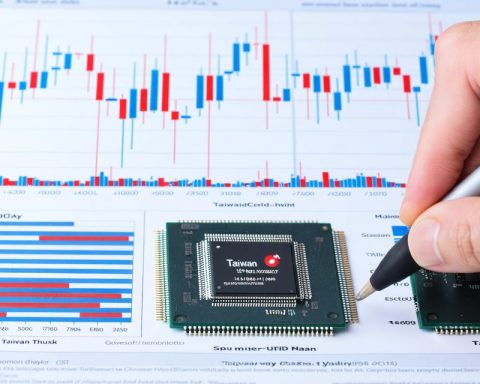- Pegasystems reported Q4 revenue of $490.8 million, surpassing expectations with a 3.5% year-on-year increase.
- Despite positive revenue performance, stock prices fell 5.1% to $100.61 post-announcement.
- Revenue guidance for the coming year is strong at $1.6 billion, though future earnings per share projections disappoint.
- Growth is anticipated to slow, with analysts projecting a 5.6% increase next year.
- Pegasystems demonstrated strong cash generation, achieving an 18.8% free cash flow margin.
- Investors are advised to focus on long-term trends and valuation amid short-term fluctuations.
- The company’s role in automation and AI presents ongoing opportunities despite current market concerns.
In the labyrinth of enterprise software, Pegasystems etches its name with impressive yet paradoxical performance. The company recently unveiled its fourth-quarter results, surpassing revenue expectations with $490.8 million in sales—a 3.5% increase year-on-year and a 4.4% jump above Wall Street forecasts. Yet, this financial ballet leaves investors pondering the next steps as stock prices dipped by 5.1% to $100.61 post-announcement.
Pegasystems, a longtime player in workflow automation, rides on the technological wave with innovative AI techniques, transforming mundane tasks into seamless operations. Despite a promising revenue guidance for the upcoming year, projecting $1.6 billion at its midpoint, the anticipated earnings per share fall short of expectations. With an adjusted EPS of $1.61 beating estimates, the outlook muddied as future projections miss the mark. Analysts now cautiously watch a deceleration in growth, forecasting a 5.6% rise over the next year.
However, Pegasystems balances this narrative with its prowess in cash generation. The free cash flow margin soared to 18.8% this quarter, a noteworthy improvement from its previous performance. This robust cash flow signifies a strategic advantage, allowing for fluid investment in new technology and potential shareholder returns.
Yet, the market remains wary. As shares dipped, the conundrum looms: should one buy Pegasystems amidst the clamor? The answer requires looking beyond quarterly rhythms to the steady pulse of long-term trends and valuation—the ultimate determinants of whether this software giant will ascend in the digital age’s hall of winners.
In this complex dance of numbers and strategy, Pegasystems challenges investors to see beyond the surface, to the gleaming opportunities on the horizon of automation and AI.
Pega’s Paradox: A Rollercoaster Ride in the AI Software Landscape
Expanded Analysis: Pegasystems’ Financial Dynamics and Market Position
While Pegasystems recently made headlines with its impressive fourth-quarter revenue of $490.8 million, surpassing Wall Street expectations, the subsequent dip in stock prices has raised questions among investors about the company’s long-term prospects. To gain a more comprehensive understanding, let’s delve into additional insights and context that affect both Pegasystems and the broader technology sector.
1. The Role of AI in Workflow Automation:
Pegasystems’ core strength lies in its innovative use of AI to automate workflow processes. By implementing AI technologies, the company enables businesses to optimize their operations, decrease labor costs, and improve efficiency. Gartner, a leading research and advisory company, predicts that by 2025, AI-driven processes will handle at least 25% of all customer service operations. This trend could substantially benefit Pegasystems as businesses continue to transition towards automated solutions.
2. Global Market Influence:
The global market for workflow automation and AI software is expanding rapidly, with major players investing heavily in these technologies. According to Grand View Research, the AI market size was valued at $62.35 billion in 2020 and is expected to expand at a compound annual growth rate (CAGR) of 40.2% from 2021 to 2028. Pegasystems is well-positioned to capitalize on this growth, given its strong foothold in AI-driven automation.
3. Investment in Cloud Solutions:
Pegasystems’ strategic focus on cloud-based solutions is another critical factor. Cloud computing continues to revolutionize data storage and computational power across industries. As businesses increasingly migrate to the cloud, Pegasystems could see sustained demand for its cloud-native solutions, bolstered by strategic partnerships and innovative product offerings.
4. Financial Health and Strategic Investments:
Despite some concerns over its earnings per share forecasts, Pegasystems’ growth in free cash flow margin to 18.8% reflects strong financial health. This liquidity empowers the company to strategically fund new technology investments, potentially driving future growth and enhancing shareholder value.
5. Long-term Growth and Valuation Considerations:
The future growth of Pegasystems may hinge on its ability to innovate and adapt in an ever-evolving tech landscape. Investors must weigh the current slowdown in PEG’s growth rate against its potential for transformation and continued relevance in the AI and automation space. While short-term setbacks might dampen spirits, long-term trends in digitization suggest a positive outlook for companies like Pegasystems.
Key Questions to Ponder:
– How will Pegasystems maintain its competitive edge in a rapidly evolving AI landscape?
– In what ways can the company leverage its robust cash flow to fuel innovation and sustain growth?
– How do market trends and technological advancements impact Pegasystems’ future?
For further information, you can explore reputable resources such as:
– Pegasystems
– Gartner
– Grand View Research
Pegasystems presents a fascinating case of a tech giant navigating the complexities of modern enterprise software while positioning itself for future success in the digital era. As the intersection of AI and workflow automation unfolds, Pegasystems remains a key player to monitor closely.

















